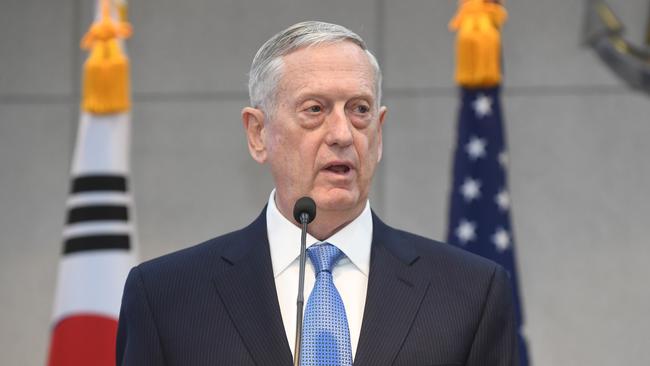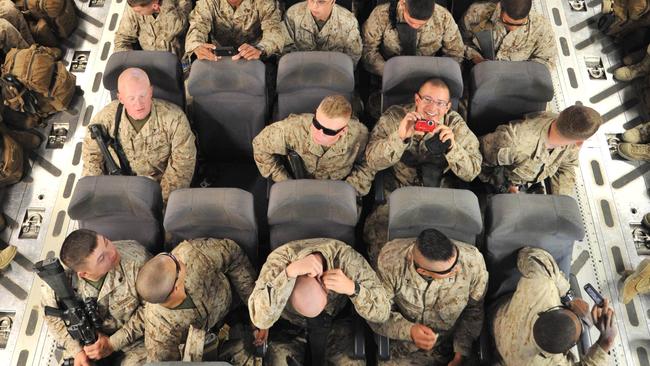
Mao Zedong once wrote: “Politics is war without blood, and war is politics with blood.” Donald Trump might agree. Then again, he might say war and politics are just subsets of business. Given the aggressive tone of his administration’s debut — and his boorish belabouring of Malcolm Turnbull in this week’s initial conversation between the two leaders — I’m setting aside my usual focus on strictly military matters to stray into the realm of higher national security strategy, where war, politics and economics meet. Here are a few tentative observations on Trump’s first few weeks.
First things first: Trump’s bragging, bullying and dismissive demeanour towards the Prime Minister was utterly typical of the man and worryingly consistent with his administration’s transactional approach to alliances — even, apparently, those as longstanding as the one with Australia, which has seen Aussies and Americans fight together on battlefields worldwide for a full century.
If there’s a silver lining to the President’s tantrum it is that a stoush with Trump may paradoxically improve Turnbull’s standing in the eyes of an Australian public that is deeply, and rightly, sceptical of the new US administration.
The clearly transactional approach coming out of Washington almost certainly will also prompt Australian leaders to impose much stricter scrutiny on any future requests for military commitments.
The substance of the disagreement between the two heads of government was, of course, immigration and refugee policy, and Trump’s aggressive start to the administration was strongly evident in his executive order suspending immigration from seven Muslim-majority countries affected by terrorism, and indefinitely halting Syrian refugee entries.
The order drew huge protests at US airports and created vast disruption for little or no gain. The presentation was more extreme than the reality: the temporary suspension of immigration from terror-affected countries mirrored a six-month suspension of Iraqi visas imposed by Barack Obama in 2011, and the seven countries affected by the ban were drawn from a threat assessment prepared last year, also under Obama.
But leaving aside the substance of the order (which will probably have a neutral or negative effect on national security), its implementation was so catastrophically incompetent that it clearly represents the new administration’s first big failure.
The chaos of the order’s rollout was at least as damaging as anything in the policy itself. Failure to brief border officers ahead of time, failure to announce clear exemptions for green card holders and for Iraqis and Afghans issued special visas after fighting alongside US forces, and springing the decision on Republicans in congress made things even worse. A dissent cable written by career diplomats quickly went viral within the State Department, while lawsuits challenging the order sprang up, prompting a revolt by acting attorney-general Sally Yates (an Obama appointee), who refused to defend it in court and was promptly sacked.
Then, on Sunday evening, six attendees at a city mosque in Quebec were gunned down, allegedly by Alexandre Bissonnette, a French-Canadian university student, in what the Canadian government quickly described as a terrorist attack. Bissonnette is allegedly a supporter of French populist politician Marine Le Pen and of Trump, and some saw the shooting as a direct outcome of the immigration ban. This was a stretch: the mosque has been targeted with anti-Muslim propaganda for some time, and Bissonnette’s views and actions seem to date from well before Trump’s election. Still, it’s a valid concern that inflammatory rhetoric, and actions perceived as anti-Muslim, may give permission to radicals for violent action against minorities. Trump’s political opponents have seized on this concern, and there have been reports of anti-Muslim vigilante action since his election, though several turned out to be hoaxes.
A further implication, shocking for those who tried to take Trump “seriously, but not literally” during the election campaign, is that this is a President who plans to deliver fast on his promises. That’s a good thing, I guess, if you agree with his policies, which many Americans do. But perhaps an even larger number don’t, or are uncertain about Trump, and events such as this are unlikely to reassure them.
All new administrations start with a steep learning curve, and the immigration fiasco demonstrates that Trump’s — filled with outsiders and provocateurs (not least the President himself) — will have a steeper curve than most. Failure to include allies in congress or bring the executive agencies along reflects the outsider pose Trump adopted during the campaign: many in his team see congress and the agencies as part of the problem he was elected to solve, so their reluctance to share plans is hardly surprising. But at some point, if they want to govern, they’ll need to start including the government in the discussion.
Barely noticed amid the chaos of the immigration ban and the Quebec shooting was America’s first combat death on Trump’s watch. A raid by Navy SEALs on a fortified compound in Yakla, in Yemen’s al-Bayda province, turned into a firefight that drew in Harrier strike aircraft and US Marine Corps reinforcements, resulting in the loss of an Osprey V22 tilt-rotor aircraft, the wounding of two marines and the death of Chief Special Warfare Operator William “Ryan” Owens. The Pentagon claimed 14 militants killed, while local sources alleged several civilians also died, including the eight-year-old daughter of Yemeni-American al-Qa’ida ideologue Anwar al-Awlaki.
The operation, on the surface, seemed to make good on Trump’s promise of immediate aggressive action against Islamic State. The reality, again, was different: the target was al-Qa’ida, the raid had been planned under Obama, and it was approved by Trump’s team as part of an ongoing campaign against al-Qa’ida in the Arabian Peninsula that has seen multiple drone strikes in this part of Yemen over the past few years, though no “boots on the ground” since 2014.
The alleged death of Awlaki’s daughter — which seemed to support Trump’s campaign pledge to “go after the families” of terrorists — was, if true, almost certainly an error rather than a case of deliberate targeting.
Even if deliberate, it would simply have built on Obama-era actions: Awlaki himself, an American citizen, was killed in a September 2011 drone strike authorised by Obama. A month later, another strike killed Awlaki’s 16-year-old son Abdurahman, also a US citizen and with no known connection to terrorism, who had gone to Yemen to search for his father. For better or worse, then, the Yemen raid represents more continuity than change in US efforts.
On the political side, one of the new President’s decisions seemed boringly bureaucratic but was really a big deal: Trump reshuffled the National Security Council, his advisory staff for national security affairs.
He gave his political strategist Steve Bannon a formal position while demoting Director of National Intelligence James Clapper and the chairman of the Joint Chiefs of Staff, General Joseph Dunford, from permanent to “as-required” attendees. He later announced Clapper would be replaced by new CIA director Mike Pompeo. Simultaneously, retired lieutenant general Michael Flynn, the National Security Adviser, appointed several former military officers to the NSC staff.
The reshuffle prompted outraged claims that Trump was militarising the NSC — Slate journalist Fred Kaplan said Bannon’s appointment was “not just a terrible idea, but illegal” — but the substance was less dramatic. Obama, after all, had his political advisers sit in on many NSC principals committee meetings, later making key decisions with those advisers, or alone. Likewise, several Obama NSC staffers were former military officers and his first national security adviser, Jim Jones, was a former general.
The replacement of DNI with CIA may reflect tension between Clapper and Flynn, who previously headed the Defence Intelligence Agency. Or it may reflect a belief that CIA needs to return to its co-ordinating role in the US intelligence community, a position it held (in theory) before DNI’s office was created in 2005. A case could be made for this, though DNI — and many members of congress, who sponsored his organisation’s creation after the 9/11 attacks — would likely disagree.
The change is also taking place against the background of tension between Trump’s team and professional officers at the intelligence agencies, many of whom regard Russian manipulation of the 2016 election in favour of Trump as a proven fact. The President’s retort — essentially, “Who are you going to believe? Me, or the guys who said it was a ‘slam dunk’ that Saddam Hussein had weapons of mass destruction?” — was arguably fair, but probably won him few friends at Langley.
More consequential is Dunford’s demotion. This may reflect the stature and expertise of the new Secretary of Defence, former Marine general James Mattis. As Trump already has a retired Marine general, the argument might go, why bring in another to offer competing advice?
In fact, the chairman’s role as the President’s principal military adviser is critical, and I would be surprised if Mattis — a well-regarded and principled man who understands the difference between military strategy and defence policy — doesn’t move to preserve the chairman’s role. More broadly, expectations are high that Mattis will exercise a restraining, adult-in-the-room influence on other members of the administration. This is both unrealistic and unfair to Mattis; this is Trump’s administration, and he will set the tone.
If the NSC reshuffle, the immigration crackdown and the Yemen raid illustrate the emerging intersection of war and politics in the Trump era, the President’s approach to business quickly began to come out, through showdowns with Boeing and Lockheed Martin. The two defence contractors sell the Pentagon much of its hardware, and Boeing provides the aircraft — effectively a flying White House — that every president since World War II has used as an airborne command post.
On December 6, Trump tweeted: “Boeing is building a brand new 747 Air Force One for future presidents, but costs are out of control, more than $4 billion. Cancel order!” He added he thought the cost was “ridiculous” and Boeing was “doing a little bit of a number”.
Boeing shares immediately fell 0.5 per cent, even though it was unclear where Trump had found the $US4bn figure. The real cost is around $US2.9bn ($3.8bn), spread over multiple aircraft and budget years, and relating more to the complex electronics and defensive systems than the airframe. Still, given the power of a presidential tweet to move markets, Boeing CEO Dennis Muilenburg was forced to respond immediately, scheduling talks with Trump and committing to trim the cost.
A week later, Trump critiqued Lockheed Martin’s F-35 Joint Strike Fighter program, tweeting that its costs were “out of control”. Lockheed’s market value quickly dropped by $US4bn. Then, just before Christmas, he invited the armed service chiefs to his Florida mansion, quizzed the generals and admirals on a series of projects, and questioned them closely on why programs were so expensive. According to people familiar with the meeting, he then announced that Lockheed Martin CEO Marillyn Hewson was waiting outside, called her in and confronted her about the F-35’s cost. It was like a reality TV episode, with the generals as decorative backdrop for a dramatic intervention.
After meetings with Muilenberg and Hewson, Trump held a press conference where he spoke about increasing the cost-effectiveness of defence procurement. Boeing later announced it would cut the cost of Air Force One.
The next day Trump tweeted: “Based on the tremendous cost and cost overruns of the Lockheed Martin F-35, I have asked Boeing to price-out a comparable F-18 Super Hornet!” There is, of course, no such thing: the F-35 is a fifth-generation multi-role aircraft with capabilities well beyond those of the 1990s-era Super Hornet, which is precisely why so many countries (including Australia) have chosen it to replace the F-18.
Beyond Trump’s market-moving Twitter stream, and his apparent lack of understanding of the difference between the warplanes, this prompted concern about presidential intervention in the defence contracting process.
Defence acquisition is a highly regulated system, subject to a vast array of rules, processes and procedures, and losing bidders often mount intense protests and court challenges when there’s any whiff of a suggestion that their competitors may have benefited from political interference, or that proposals have been judged on anything other than the merits.
The appearance, let alone the reality, of a quid pro quo — say, hypothetically, one where Boeing cuts the cost of Air Force One in return for a shot at Lockheed’s flagship F-35 project — could prompt chaos in the defence sector, threatening many of the industrial jobs Trump’s interventions seem designed to protect.
There is, of course, much more to discuss about Trump’s first few weeks.
The Taiwan/China policy emerging under the new administration appears much more hawkish than Obama’s, while the attempt at rapprochement with Russia seems real but is running into contradictions such as Russia’s support for Iran, a country Trump believes Obama appeased through the 2015 nuclear deal, and which he is seeking to contain.
North Korea’s missile test and the steadily increasing level of al-Qa’ida, Islamic State and Taliban activity in Afghanistan show the potential for security crises that could rapidly derail Trump’s first-term agenda, just as such crises have derailed so many previous presidents. And it’s early days yet.
Still, some clear themes are beginning to emerge: the contrast between presentational fanfare and relative policy continuity is one. The bullying, bragging, transactional tone Trump seems unable to avoid in his relations with allies is part of this. The combination of arrogance and incompetence in executing national security decisions is another — one that’s in no way unique to this administration, of course. The readiness to wade into complex issues such as defence contracting, with little knowledge of the procurement system or understanding of the programs involved, and less care for the market impact of casual tweets, is another.
For the President’s opponents, the lesson seems to be: pick your battles. There will be a steady stream of incidents, and treating each one like an unprecedented outrage makes it hard to sustain opposition. This is particularly true when the substance (as in the Yemen raid, or the immigration ban) shows strong continuity with previous policy.
For Trump’s supporters, the lesson seems to be: don’t assume more of a mandate than you have. Not everyone who voted for Trump supports him; many were mainly voting against Hillary Clinton, or wanted to give an outsider a go at fixing entrenched problems.
Even those who support some part of his agenda may oppose him on other issues. And incompetent execution can quickly undermine support, however much voters like policies in theory.
For allies such as Australia, or for NATO nations, or for the other countries involved in Lockheed’s F35 program, or the signatories to the Iran nuclear deal, the message seems to be: hang on to something solid, this is going to be a wild ride.




To join the conversation, please log in. Don't have an account? Register
Join the conversation, you are commenting as Logout